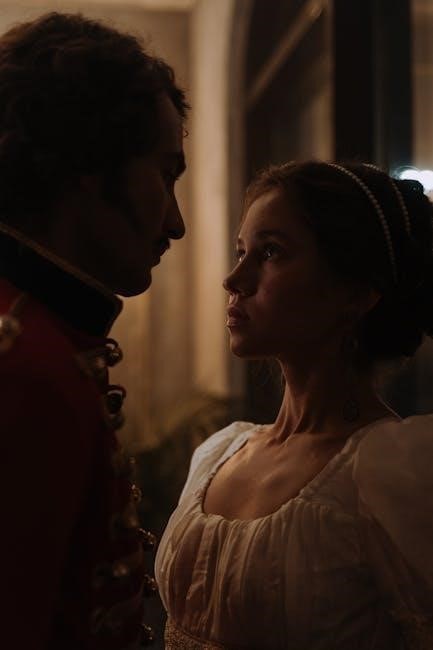Overview of “A Gentleman’s Guide to Love and Murder”
A Gentleman’s Guide to Love and Murder is a musical comedy set in 1907 London. The plot revolves around Monty Navarro‚ who discovers he is ninth in line for an earldom and resorts to murder to expedite his ascent.

Plot Synopsis
The musical comedy follows Monty Navarro who discovers he’s ninth in line to inherit a fortune. Driven by ambition‚ he cleverly eliminates eight relatives. This quest leads to love‚ social climbing‚ and dark humor.
Monty Navarro’s Discovery
The story commences with Monty Navarro‚ a commoner‚ attending his mother’s funeral. Following the service‚ he is approached by Miss Shingle‚ who reveals a shocking secret: Monty is‚ in fact‚ a DYsquith. His mother had been disowned by the wealthy DYsquith family for marrying beneath their social standing. This revelation places Monty ninth in line to inherit the Earldom of Highhurst. Initially dismissive‚ Monty soon realizes the implications of this discovery. Spurred by both a desire for social advancement and a yearning to win the affections of the unattainable Sibella Hallward‚ Monty begins to contemplate the rather drastic measures needed to shorten the line of succession standing between him and the esteemed title. This sets the stage for the murderous events that unfold.
The DYsquith Family
The DYsquith family represents the epitome of Edwardian wealth and aristocracy‚ embodying the societal barriers that initially prevent Monty from achieving his desires. They are a diverse and eccentric group‚ each member possessing unique quirks and flaws. They stand as obstacles to Monty’s inheritance. They are holding the key to the Earldom of Highhurst. Their demise becomes integral to Monty’s ambitious plans. They include a variety of professions and personalities‚ from a clergyman to a bodybuilder. Each DYsquith’s death is cleverly orchestrated‚ showcasing Monty’s evolving cunning. This family’s prominence and Monty’s connection to them‚ sets up the central conflict. The DYsquith family serves as the primary subject of Monty’s murderous intentions.
Monty’s Murders
Monty’s journey to becoming the Earl of Highhurst involves a series of carefully planned and darkly comedic murders of the DYsquith family members who stand between him and the title. These killings are not portrayed as gruesome‚ but rather as farcical‚ often with ironic twists. Each murder is uniquely tailored to the victim’s personality or circumstances. This showcases Monty’s growing audacity; The deaths are inventive and often accidental-seeming‚ raising questions of morality. The audience is invited to laugh at the absurdity of the situations. As he goes‚ Monty’s actions are driven by ambition and a desire for social advancement; The murders are a central device. This is a journey from a penniless clerk to a potential earl.
Love Interests: Sibella and Phoebe
Monty’s romantic entanglements with Sibella Hallward and Phoebe DYsquith add complexity to the plot. Sibella is his initial love‚ a vivacious but calculating woman who prioritizes wealth and social status. This leads her to waver between Monty and a wealthier suitor‚ creating tension. Phoebe‚ on the other hand‚ is a sweet and innocent DYsquith relative. She is a direct contrast to Sibella‚ and offers Monty genuine affection. His affections become torn‚ complicating his plans. These relationships become intertwined with his murderous schemes‚ adding layers of moral ambiguity. His choices are driven by both love and ambition. These romantic interests impact the plot and his decisions. This results in a love triangle.

Characters
The musical features Monty Navarro‚ the DYsquith family members (all played by one actor)‚ Sibella Hallward‚ and Phoebe DYsquith. These characters drive the plot and themes of ambition‚ love‚ and social climbing.
Monty Navarro
Monty Navarro‚ a penniless clerk in Edwardian London‚ is the central figure of A Gentleman’s Guide to Love and Murder. He discovers‚ after his mother’s death‚ that he is ninth in line to inherit the Earldom of Highhurst. Fuelled by ambition and a desire for a better life‚ especially to win over Sibella‚ Monty decides to eliminate the eight relatives standing in his way.
His journey involves navigating complex relationships with his love interests and the DYsquith family. Despite his murderous actions‚ Monty possesses a certain charm and wit that keeps the audience engaged. He is a complex character driven by circumstance and desire.
The DYsquith Family (Multiple Roles)
The DYsquith family in A Gentleman’s Guide to Love and Murder represents the wealth and privilege that Monty Navarro seeks. A single actor embodies all eight DYsquith family members who stand between Monty and the earldom. These characters range from a philanthropic clergyman to a bodybuilder.
Each DYsquith is an obstacle in Monty’s path. Their deaths are often accidental or indirectly caused by Monty’s actions. The portrayal of multiple roles by one actor adds to the comedic effect. Each DYsquith family is a caricature of Edwardian society. Their demise fuels Monty’s dark journey towards social climbing.
Sibella Hallward
Sibella Hallward is one of Monty Navarro’s two love interests in A Gentleman’s Guide to Love and Murder. She is a beautiful and ambitious woman who is hesitant to marry Monty due to his lack of wealth and social standing. Sibella’s primary motivation is to marry a man of high status and fortune‚ leading her to pursue other suitors.
She is aware of Monty’s affection but prioritizes her own advancement. Her relationship with Monty is complicated by her engagement to Lionel Holland‚ a more socially advantageous match. Sibella represents the societal pressures and the allure of wealth that influence romantic decisions.
Phoebe DYsquith
Phoebe DYsquith is the second of Monty Navarro’s two love interests in A Gentleman’s Guide to Love and Murder. She is a sweet‚ virtuous‚ and intelligent young woman who is also a member of the DYsquith family‚ making her a distant relative of Monty. Unlike Sibella‚ Phoebe is less concerned with social status and more interested in genuine affection.
Phoebe develops a strong connection with Monty‚ unaware of his murderous actions toward her family. She represents innocence and the possibility of love untainted by ambition. Her presence creates a moral conflict for Monty as he juggles his affections and his homicidal goals.

Musical Aspects
The musical score of A Gentleman’s Guide to Love and Murder features witty lyrics and classic‚ old-timey musical hall influences. The music enhances the comedic and farcical nature of the plot.
Music and Lyrics by Steven Lutvak
The musical brilliance of A Gentleman’s Guide to Love and Murder is primarily attributed to Steven Lutvak‚ who composed both the music and lyrics. Lutvak’s work is characterized by its wit‚ charm‚ and cleverness‚ perfectly complementing the farcical nature of the plot. His compositions evoke a classic‚ old-timey musical hall feel‚ adding to the show’s Edwardian aesthetic. The lyrics are filled with intricate wordplay and dark humor‚ enhancing the comedic storytelling.
Lutvak’s contributions were crucial to the success of the musical‚ earning him widespread acclaim and establishing him as a promising figure in musical theater. His ability to blend catchy melodies with intelligent lyrics created a memorable and engaging experience for audiences. The musical’s distinctive sound is a testament to Lutvak’s talent.
Original Broadway Production
A Gentleman’s Guide to Love and Murder premiered on Broadway at the Walter Kerr Theatre on November 17‚ 2013. The original production was directed by Darko Tresnjak and featured Bryce Pinkham as Monty Navarro. Jefferson Mays played all eight members of the DYsquith family‚ a feat that became a defining characteristic of the show.
The Broadway production was a critical and commercial success‚ celebrated for its clever staging‚ witty performances‚ and overall entertainment value. It received ten Tony Award nominations in 2014‚ winning four‚ including Best Musical and Best Direction. The show ran for over two years‚ closing on January 17‚ 2016‚ solidifying its place as a modern classic.
Themes
The musical explores themes of ambition‚ social climbing‚ love‚ and class differences through dark humor and farce. Monty’s actions highlight the lengths one will go to for status.
Ambition and Social Climbing
Ambition is a central theme in A Gentleman’s Guide to Love and Murder‚ driving Monty Navarro’s actions throughout the play. Upon learning he is ninth in line to inherit the Earldom of Highhurst‚ Monty’s desire for a better life ignites. This ambition fuels his calculated plan to eliminate the eight relatives standing in his way‚ showcasing the extreme measures he takes to climb the social ladder. His pursuit of wealth and status is intertwined with his romantic interests‚ further emphasizing his determination to elevate his position in society. The play satirizes the societal obsession with titles and fortunes. Monty’s social climbing is propelled by both love and greed. He is willing to go to increasingly dangerous lengths‚ revealing the dark side of ambition. The musical cleverly uses Monty’s journey to critique Edwardian society’s rigid class structure.
Love and Class
A Gentleman’s Guide to Love and Murder intricately explores the interplay between love and class in Edwardian England. Monty Navarro’s romantic pursuits are heavily influenced by his social standing and his ambition to climb the social ladder. His initial love interest‚ Sibella Hallward‚ is drawn to wealth and status‚ rejecting Monty due to his poverty. This rejection fuels his desire for upward mobility‚ driving him to pursue the earldom. His relationships with both Sibella and Phoebe DYsquith highlight the constraints imposed by class distinctions. Phoebe‚ as a DYsquith‚ represents a step up in social status for Monty. The musical satirizes the societal norms that dictate romantic choices based on wealth and titles‚ revealing the complexities of love in a class-conscious society. Monty’s actions are motivated by a desire to overcome these barriers.
Dark Humor and Farce
A Gentleman’s Guide to Love and Murder thrives on dark humor and farcical elements‚ creating a uniquely entertaining theatrical experience. The musical embraces the absurdity of its premise‚ where murder is treated with a lighthearted and comedic tone. The over-the-top characters‚ particularly the DYsquith family members played by a single actor‚ contribute to the farcical nature of the show. The intricate and often ridiculous methods Monty employs to eliminate his relatives add to the comedic effect. The juxtaposition of murder with elegant Edwardian settings and witty musical numbers creates a delightful sense of irony. The humor is further enhanced by the play’s clever use of double entendres and slapstick moments. This blend of dark themes and comedic execution is what defines the show’s distinctive appeal‚ making it a riotous and unforgettable romp.

Critical Reception and Awards
A Gentleman’s Guide to Love and Murder garnered widespread critical acclaim‚ praised for its wit‚ music‚ and farcical humor. The show received numerous awards‚ solidifying its place as a hit musical.
Tony Awards
A Gentleman’s Guide to Love and Murder was a major contender at the 2014 Tony Awards‚ receiving a total of ten nominations. The production won four Tony Awards‚ including Best Musical‚ Best Direction of a Musical for Darko Tresnjak‚ and Best Book of a Musical for Robert L. Freedman. Peggy Hickey won for Best Costume Design‚ solidifying its impact on the Broadway stage. This recognition highlighted the show’s quality‚ its comedic brilliance‚ and impressive production values. The Tony wins underscored the musical’s success in captivating audiences and critics alike‚ cementing its legacy as a significant contribution to musical theatre. Winning Best Musical was the ultimate recognition‚ celebrating all aspects of the production.
